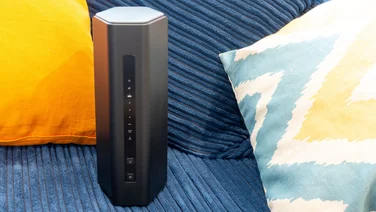To help us provide you with free impartial advice, we may earn a commission if you buy through links on our site. Learn more

















- Impressive wireless performance
- Terrifically versatile firmware
- Extensible via AiMesh platform
- Less bandwidth than most full-sized routers
- No internal battery
- No native SIM slot
It’s not a hotly contested accolade, but the Asus RT-AX57 Go is one of the smallest Wi-Fi 6 routers we’ve ever tested. It’s designed for portability – hence the name – and it weighs just 210g.
Although intended to serve as a go-anywhere hotspot, the Asus RT-AX57 Go lacks a built-in battery, so wherever you take it you’ll need an external power source. It also doesn’t have its own SIM slot, which means getting online requires an Ethernet WAN connection, or a 5G dongle – or, you can tether a smartphone over USB.
These omissions mean the RT-AX57 Go isn’t as conveniently portable as, for example, the Netgear Nighthawk M5. However, the price is a lot lower, and Asus’ firmware is hugely versatile, making the RT-AX57 Go a great choice for anyone needing a small, self-contained router.
Asus RT-AX57 Go review: What you need to know
The Asus RT-AX57 Go is a fully featured Wi-Fi 6 router, with most of the same capabilities as Asus’ upmarket models. However, it’s designed to be small, lightweight and affordable, and this has a few implications for its specification.
In particular, its Wi-Fi transmitter is limited to a top speed of 2.4Gbits/sec on the 5GHz band, via 2×2 MIMO. Wired connectivity is also limited, with only one gigabit Ethernet socket available for LAN clients. There is, however, one USB-A connector, which can be used for a variety of purposes, as I’ll discuss below.
With these hardware choices, the Asus RT-AX57 Go is best suited to sharing an existing internet connection over a modest radius. It could be ideal for a nascent microbusiness needing a secure, manageable internet hotspot, while larger companies might find it useful for a remote workspace, a trade show booth or a working awayday.
READ NEXT: Best wireless routers
Asus RT-AX57 Go review: Price and competition
The RT-AX57 Go isn’t the first portable router we’ve seen. We’ve previously praised the TP-Link Archer MR600 4G+, a mini-router with an internal SIM slot and a full four Ethernet sockets. However, at £120 it’s more expensive than the Asus, and is limited to 4G mobile data and Wi-Fi 5 networking. A more compact option is the credit card-sized TP-Link M7650, whose internal battery promises to serve up 15 hours of internet access on a full charge. The price is higher still, though, at £180 and again it’s limited to 4G and Wi-Fi 5.
In fact, if you’re looking for a portable router that’s up to date with current networking standards, the best option we’ve seen is the Netgear Nighthawk M5, a premium portable hotspot with a long-lasting battery, a snazzy touchscreen and full 5G support. However, at £760, it’s fair to say that it’s in a different price category to the Asus.
It’s worth remembering that if you just need an occasional, ad hoc internet connection, you can configure any Android or iOS smartphone to operate as a wireless hotspot, sharing its own mobile data connection. This may not give you the performance or range of a portable router, but it can’t be beaten for convenience and value.
If portability isn’t a priority, there are also some decent regular routers to consider in this price range. The Linksys MR7350 is several years old, but it delivers solid Wi-Fi 6 performance and can now be had for a knocked-down £66. D-Link’s R32 Eagle Pro AI is another unassuming option at £158, while Asus’ own RT-AX59U provides similar features to the RT-AX57 Go in a full-sized domestic router format for £125.
Asus RT-AX57 Go review: Design and features
The RT-AX59U is pleasingly small and slim, with a square plastic case measuring 120mm along each side that’s 21.5mm thick. As I’ve noted, it weighs a mere 210g, about the same as a large-screen smartphone. Power requirements are similarly lightweight: I measured a mains draw of just 4.7W when the router was sitting idle with nothing connected to the LAN port, peaking at 6W during my file-copy tests.

















Conveniently, the power socket is a standard USB-C connector, so if you don’t want to carry the provided power supply around you can run it off any smartphone charger or battery pack that supports the 9V USB PD standard.
The router’s compact design doesn’t allow much space for lights or connectors. A single multicoloured LED on the right-hand side of the unit conveys the router’s status; at the rear sit the two gigabit Ethernet ports, one for an incoming internet connection, the other for connecting a single wired LAN client. If you don’t have a WAN connection available, you can use the USB 3 socket to plug in a 4G or 5G mobile data adapter, or to piggyback off the internet connection of an Android mobile phone. Otherwise, you can use this port to share a USB storage device or a printer.

















While the small format of the router has its appeal, I did find that the weight of the connected Ethernet cables kept dragging the RT-AX57 Go off the edge of my desk and onto the floor, until I strategically plonked a book on top of them to hold everything in place. Things get even more unstable if you use the little white plastic mount that’s supplied in the box to stand the router upright. The best way to keep the RT-AX57 Go in place is to use the wall-mounting holes on the underside, which rather undermines the point of a portable router.
The RT-AX57 Go may be physically quite minimal, but there’s nothing cut down about the software. Whether you choose to manage it from the web portal or the glitzy smartphone app, you get all the same features as found on Asus’ premium routers, with nothing cut back or excluded. That includes the company’s parental controls and active network security features – all free to use forever – plus the AiCloud remote access service and a fully functional firewall.

















Asus’ excellent VPN support comes along, too: as well as serving as a general internet gateway, the RT-AX57 Go can act as an incoming VPN server for your home network, optionally using the fast WireGuard protocol – a feature we haven’t seen on other routers.
Alternatively, you can configure it as an outbound gateway, automatically routing traffic from specific clients through up to 16 different external VPN servers. Integration with Surfshark is built in, but you can use any service that supports WireGuard, OpenVPN, PPTP or L2TP tunnelling. A nice touch that’s specific to the RT-AX57 Go is a programmable physical switch on the side of the device, which can be used to conveniently turn VPN services on and off.

















Another feature that isn’t found on most Asus routers is “Guest Network Pro”, an enhanced guest network that includes a customisable captive portal that’s ideal for small businesses. Alternatively, with a few clicks you can configure the secondary SSID as a dedicated kids’ network with parental controls, as an isolated space for IoT devices or as a dedicated VPN-enabled network.
Finally, if you want to expand the RT-AX57 Go’s networking horizons, you can use Asus’ AiMesh feature to pair it with almost any other Asus router, either wirelessly or over Ethernet, to gain extra wireless range and additional network ports.
READ NEXT: Best mesh Wi-Fi routers
Asus RT-AX57 Go portable router review: Performance
The RT-AX57 Go’s small size and low power requirements are great for portability, but what do they mean for Wi-Fi range and connection speeds? To find out, I installed the router in the study at the front of my home and connected an Asustor AS3304T NAS appliance to the LAN port. I then connected my test laptop to the router’s 5GHz Wi-Fi 6 network, carried the laptop around to various rooms in my home and measured upload and download speeds when copying files to and from the NAS.
It’s worth mentioning that Asus ships its routers with the 5GHz channel width set to a maximum of 80MHz, rather than the full 160MHz supported by Wi-Fi 6. This reduces radio interference, but it also limits the bandwidth of the wireless network, which is why most other router manufacturers use the 160MHz setting by default. For my tests, I manually enabled the 160MHz option in the management interface.
Here are the results I saw, along with speeds from the other abovementioned routers for context:


As you can see, the RT-AX57 Go performs very creditably, especially considering its size and price. It easily outpaced all previous portable routers we’ve tested, providing strong coverage even in areas where Netgear’s and TP-Link’s pocket-sized hotspots couldn’t provide a signal at all.
The RT-AX57 Go beat some full-sized routers, too, with higher top speeds than the venerable Linksys MR7350 and stronger overall performance than the D-Link R32 Eagle Pro AI. The only router in this price range that more or less kept up in all locations was Asus’ own RT-AX59U.
These impressive numbers do come with a few caveats. First, note that the 2×2 MIMO connection between the router and the test laptop fully maxes out the RT-AX57 Go’s wireless hardware: there’s no surplus capacity, as with routers that support 3×3 or 4×4 MIMO. That means general performance will be dragged down if several clients want to use the wireless network at the same time.
Remember, too, that wired networking support is limited. The RT-AX57 Go offers only a single gigabit LAN port, and while you can use an external switch to connect multiple devices, they will all have to share the bandwidth of the host port. By contrast, the RT-AX59U has three separate gigabit Ethernet sockets.
These issues may be immaterial if you’re just planning to use the RT-AX57 Go as a pop-up hotspot, but they limit the router’s ability to grow with your needs. Again, though, AiMesh gives you options for building out your network if you need to.
Asus RT-AX57 Go review: Verdict
More than most routers, the RT-AX57 Go is designed for a specific role, and if you’re looking for a general-purpose network hub it might not be your best choice. While the Linksys MR7350 has a much more rudimentary set of software features, it delivers strong whole-home coverage for just £65. Or, for not much more than the RT-AX57 Go, the Asus RT-AX59U offers comparable performance, more bandwidth (both wireless and wired) and the same brilliant firmware.
If, however, you need a router that’s small and light enough to slip into a pocket, the Asus RT-AX57 Go has a lot going for it. While it lacks an internal battery and SIM slot, it’s overall far more capable and configurable than the TP-Link M7650, and a hell of a lot cheaper than the Netgear Nighthawk M5. It’s also a lot faster than its size and price would suggest, and even has potential for future expansion via the AiMesh platform.







